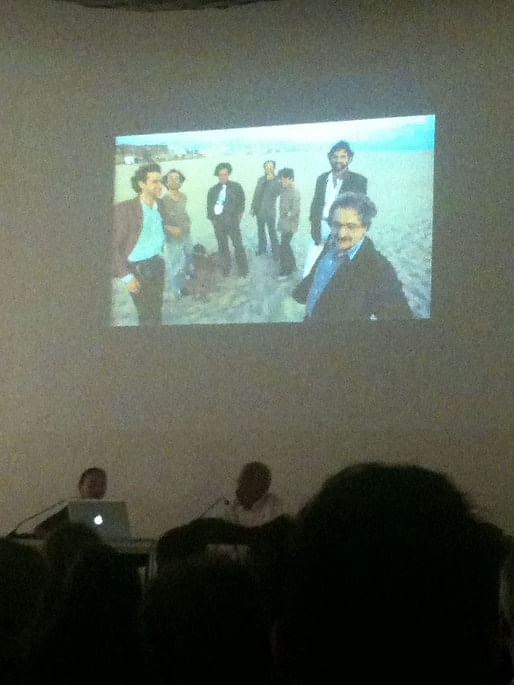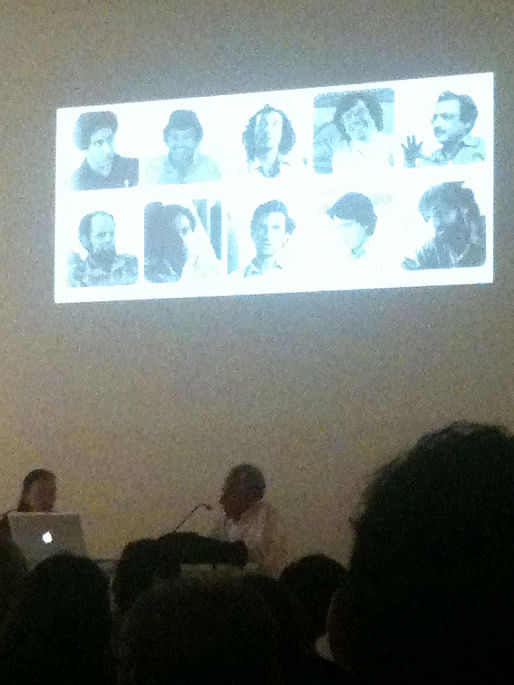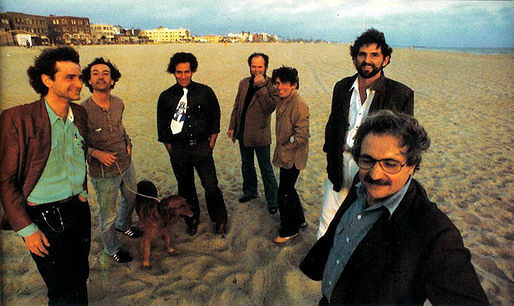
Hi Archinect!
I'm in Los Angeles (yeah!) for an ACSA board meeting and we thought we'd take in Sylvia Lavin and Eric Owen Moss at SCI-Arc.

SL: ...There are all of the different things that architects make and that we recognize as architecture in some way. And then, what are the different things that go into making an architect? So I'd like to ask you: What made you go into architecture?
EOM: What one would answer to this is different when you're a kid, versus now. So the question is: today, is it what I thought it was back then? When I was a kid, my mom was a project manager, and at some point I was asked to write about what I wanted to so. She took me to Neutra's house and said 'this is an architect.' I found him to be a little stuffy and pretentious... But I thought: if you make a jail, you're exposed to [everything that has to do with a jail; and if you make a hospital, you're exposed to the whole world of medicine; and if you make a house, you're exposed to residential life.] You are exposed to all these human endeavors. [So that was one reason why I wanted to become an architect.] And then there's an argument about the durability of architecture--it's stone--and I was interested in that too. [That was my other reason.]
SL: What did your mother do for Neutra?
EOM: She was a labor organizer, and her father was a vice president of a union. She was involved with Cesar Chavez and...at a point they even wanted her to run for congress. [At one point] her organization built a building. [She was a client of Neutra's.]
SL: Where were you in 1968?
EOM: Good question. I can remember walking down Telegraph avenue, going to school, and there were armed guards. At Berkeley, most people were following along...there was a war going on in Vietnam, and the difference between this war and the war in Iraq is that there was a draft.
SL: That's one difference.
EOM: ...I couldn't join up with either side--that was a problem for me. I didn't think the pseudo-Marxist view explained what was going on, but I also didn't agree with it...I would argue with both the police and the protesters.
SL: '68 is a year that people wear on their sleeves...
EOM: I can't stand that.
SL: And [researchers] these days are tracing passport records and finding that Bernard Tschumi was not in Paris even though be has said that he was--he wanted to have been there. [When people answer this question, their answer is much about where they wished they were, as much as where they actually may have been.]
EOM: I was trying to answer the question as honestly and honorably as possible.
SL: But I want the students to understand that when I ask where you were in 1968 it's not just a personal biographical question but a question about what past you want there to be today.
....
SL: So you went from Berkeley to the GSD and graduated the year that Gund Hall opened...
EOM: [Contradicts her] I think they were still building Gund Hall...
SL: Well, let's use this as an idea about the social grouping of architecture...the open trays.
EOM: My class at Harvard was seven people. This building changed everything--if only because you now had a big a/c bill and had to pay it...it was a factory.
SL: Let's call it a corporate floor. [Would that be a gentler way to describe the GSD?] What did you do when you returned to LA from the GSD?
EOM: I worked for a little while for William Pereira who had an interesting reputation and...I started to work with SCI-Arc and set up an office.
SL: We were talking about different kinds of offices produce different kinds of architects. These days a lot of young people divide themselves into design and corporate offices and go straight into starting their own firms without going through a corporate firm. What do you think of that?
EOM: I learned a lot about (the mechanics of running a firm)--do a project, add people, do a project, add people... But the difference between the corporate world then and today--there seem to be an intersection today between these worlds that wasn't there before. It's a soggy boundary, though maybe it shouldn't be that way.

SL: This image nauseates me...partly because I've seen it so many times. But also because at the height of feminism...and this is everything good and everything that is awful about a boy's club. I feel like it's my professional duty to say this.
EOM: I think you're attributing motives or reading something... well, that is there, I'll give you that...but the people who were there weren't thinking that. It wasn't in my head.
SL: Well my job is precisely to have something in my head that is not in your head. I'm not playing the psychoanalyst, [trying to figure out what's in your head.] What I'm doing is reading the image against its historical background. It's not meant to be personal--
EOM: I'm just saying as I recall whatever the hell I thought I was doing, standing on a beach--it wasn't intentional. I do think that letting things go instead of chasing back things that were formative in my life...I prefer to let things turn over. That's why I don't go back and say I was there in 1968.
EOM: There's a guy who's super boring, Giambattista Vico, you know him?
SL: I've been bored by him a lot more than you have.
EOM: Well, what I find interesting is his idea that you can go anywhere and be anything and penetrate--you don't have to be from just one time and place.
SL: When I ask people why they became an architect, I often get two answers. One is that 'I wanted to be an artist and my mother said I had to get a job.'
The other is an answer I got from Rem Koolhaas, who said 'it's going to sound cynical coming from me, but I became an architect because I was interested in public service.'
EOM: For me though, it was a question of biography. I didn't answer with either of those. My answer was, instead, about the durability and the ability to touch every part of a culture.
SL: Back to the image: what I find telling--
EOM: I thought you said 'repulsive.' ...Don't you find it easy to find somebody to hate?

SL: I'm really hammering this one because those of us in LA have seen these images again and again. It belongs to a typology of images about California...
...
SL: We associate schools with their directors and heads. What do you [associate] Sci-Arc with?
EOM: I'd like to look at it and say that life is personal, one architect at a time. A lot of things you talk about is external, in which each person is a composite of what comes at them. I'm interested in a more internal [point of view]. It's one architect at a time, a working out in the world of an interior life that is personal. There's an intellectual culture that would make this plausible...by availing yourself of...points of view that undermine other points of view.
SL: I don't understand how that leads to a pedagogy.
EOM: Well I'm the guy who said that SCI-Arc doesn't have a pedagogy.
SL: What do you mean when you said that it's internal?
[Frederick Fisher, Robert Mangurian, Eric Owen Moss, Coy Howard, Craig Hodgetts, Thom Mayne, Frank Gehry), 1980, Ave Pildas. Image source.]
EOM: Lets go back to your favorite...I mean, your least favorite picture. I'm not sure that any of those external qualities--the image, the tie...have to do with the insides of one's life...
SL: It's so funny that we're talking at such cross purposes, as if I found this odious because I don't like the haircuts. This photograph is of some of my favorite people, but--
EOM: But you look at this and say that it's all men...but we weren't thinking about that--
SL: Well, it is the prerogative of men to enter the world without acknowledging that they are men.
[A smattering of applause.]
SL: But that's not the only point I wanted to make: This is a group of individuals.
EOM: As opposed to a group of collectives?
SL: I think contemporary architecture suffers from the perception that its overly about the individual and inner life of the architect. That's a perception I think we have to shed.
...
[Sadly, I had to leave at this point--but for a good cause, to meet up with Paul, Nicole, and Alex of Archinect fame--but I was very glad to have witnessed this exchange between Lavin and Moss.]
Thanks for reading!
Lian
This blog was most active from 2009-2013. Writing about my experiences and life at Harvard GSD started out as a way for me to process my experiences as an M.Arch.I student, and evolved into a record of the intellectual and cultural life of the Cambridge architecture (and to a lesser extent, design/technology) community, through live-blogs. These days, I work as a data storyteller (and blogger at Littldata.com) in San Francisco, and still post here once in a while.



17 Comments
The post is lovely and completely reconfirms how much I think EOM is an idiot - full of himself with no substance. :-) Why do you all flock to SciArc with him in the drivers's seat?
TED -You have no idea what you're talking about.
Sylvia if you read this -- If I remember you can count on both hands how many women went to SCI-Arc. And feminism if I also remember correct, wasnt part of our conversations; it was all about architecture. I dont know about UCLA or USC back at the time when Eric Moss started teaching but gender issues just never came up. Equality was simply assumed in our environment.
EOM: There's a guy who's super boring, Giambattista Vico, you know him?
SL: I've been bored by him a lot more than you have.
Are these two referring to Vico the 18thC Italian Philosopher? I hope not. I have THE NEW SCIENCE OF GIAMBATTISTA VICO on my bedroom bookshelf. Not boring. Unless you consider Descates, Montaigne, Hume, Mill, Croce and all philosophers 'boring'. I hope that this is a case of mistaken identify..
Yes, the same Vico--they were being tongue in cheek.
Lian, Thanks for the clarifiction
So this Pseudo-intellectual name drop would be the equivalent of Hollywood name dropping? I sure that EOM doesn't read this stuff (just quotes enough to fake it) . Do you think Lavin knows her stuff? Or are these two a pair of talking monkeys? What is your critical take? eric
What are SCI-Arc's gender enrollment numbers now? I started architecture at a state school in 1985 and the school of 250 students was less than 20% women. I taught last year at a different state school and the gender mix was close to 50%, if anything it was slightly more women than men.
I get that it's annoying to look at these images and see how few women were involved but it's better, IMO, to look forward.
Also, that no skateboarding sign just makes my heart swell, because it implies that skateboarding is *welcome* in other areas of the building. Things are getting better.
why the fuck do they keep showing the same photos of the LA stars on venice beach again and again?
Lavin showed the picture in order to take the opportunity to make a point at the expense of EOM in front of him and an audience. Women are under represented, have not the privilege to operate in the world without constantly seeing themselves and their work as the work of people regardless of gender. This photo is repulsive to her because, as it includes none of her gender, it represents male hegemony in architecture. To EOM it is a nice memory of standing on the beach with his friends. Both points have validity, but to bully EOM to acknowledge Lavin's point.
Less stars than you think. More multiples: At this time Moss and Stafford were a team; Mangurian and Hodgets; Mayne and Rotundi; Fisher worked earlier at Frank Gehry before Fisher (Thane) Roberts; Coy Howard by himself.
All mentioned taught studio (except Roberts) at Sci-Arc.
Eric, thayne Roberts did too but I really don't get significance of his contribution to the group other than being a brief partner to Fred Fisher. Therefore I doctored this version when I resurrected this image in my Coy Howard interview few years ago. People who lived the period would know why I doctored it and know the significance of the person I switched with Thayne.
Orhan, more personal than significant. Fisher, Roberts, and Brian Murphy all shared a studio in the building where I lived, The Carlton in Ocean Park. David Lang and I took their studio space when we briefly worked together.
I didnt know Thane taught at SCI-Arc. I liked his design for Armani in Beverly Hills. That's the only design of his I know.
Eric, do you have the copy of "Sexual Intellectual" manifesto we collectively wrote and distributed as the anarchist ABC group? I mean the 8.5x11 xerox copied posters to counter Bernard Tschumi's lecture at Sci Arc in 1982 (maybe 1981)? I believe he had a broken arm at the time.
I can look. It was funny
Funny and serious in the same time. It was an early anti starchitect resistance. It made a lot of people react with a "huh?" with some followed it with a "wow!"
This occasion feels like Jeff Kipnis asking Glen Small "how does it feel to be 40 years too early Glen?"
Politics were definitely out among the so called heretics at the time and we were looked as trouble makers. I am glad some of it was recorded, though most of it was dissipated into the walls of Joker Bar on Pico.
I will look for a copy in my archives. I think I have it. It was a great title..
Eric, what i can say is that if I were in a room alone with Sylvia Lavin (or in a room not alone, or not in a room, for that matter), I would under no circumstances attempt to outsmart her.
LCC. Outsmart is a game Academics like to play. Let me put it this way. At a certain point, or level, everybody has read the same books , knows the same things. Everybody is real smart.
After that it is a matter of how you communicate,, illustrate what you want to say. I like smart. I get along with artists, scientists and intellectuals the best. Academics not so much as the talk tends to the personality politics of their institution. Or opinions ad nausea.
I am coughing now so I have to stop.
Everyone knows that was there or has seen the discussion online, that Sylvia is always trying to promote her own agenda for two things: to gain notoriety , or an attempt to deconstruct or degrade Sci-Arc at large (teachers, students) in a rude, however critical way. She may do the latter perhaps because she feels some sort of rivalry or feud between UCLA and SCi-Arc that is not necessarily said, but somewhat obvious by certain remarks she makes. " Im in your house tonight", or " what is the culture of questions here" ,and " what is Sci-arc's pedagogy", and clearly attacks Erics answers, " you are hard to follow". She clearly identifies herself as an outsider and with a cocky attitude. Her discussion with Eric was nothing more than an attempt to scrutinize and interrogate his personal life and his work and its relation between the two and its affects as the director Sci-Arc.
Eric clearly holds his ground against her questions she calls "hard ball " or "soft balls"
questions. And is able to answer the questions in way that pisses Sylvia off because she wants him to answer in away that proves her hypothesis correct, whatever that may be.
Im sure that she will not attend another debate with Eric, and Im sure Eric would not rudely interrogate her work at UCLA if invited and question there pedagogy and what type of architect they intend to produce. Because if you ask me the work that is produced there is quite similar to that of Sci-arc. It just goes to show her type of character in this profession and attitude towards SCI-Arc.
over and out.
Block this user
Are you sure you want to block this user and hide all related comments throughout the site?
Archinect
This is your first comment on Archinect. Your comment will be visible once approved.